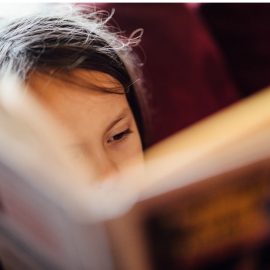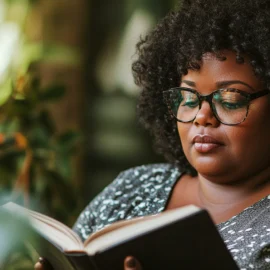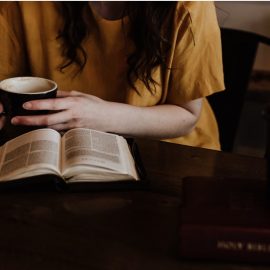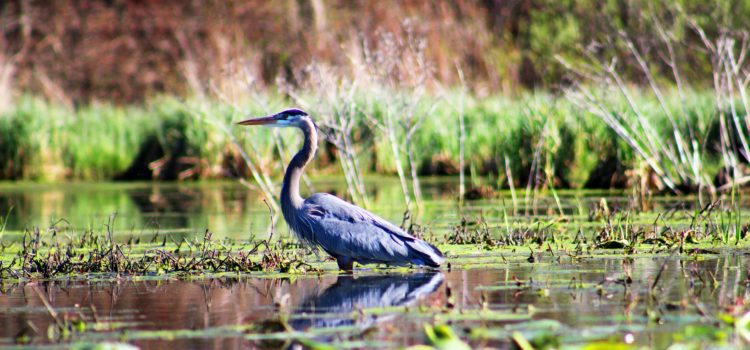
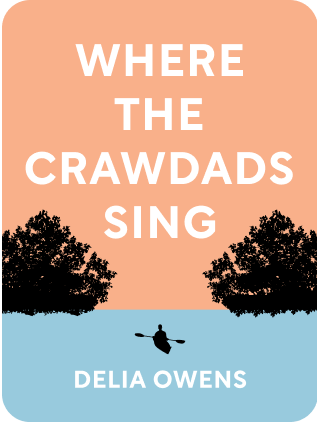
This article is an excerpt from the Shortform summary of "Where the Crawdads Sing" by Delia Owens. Shortform has the world's best summaries of books you should be reading.
Like this article? Sign up for a free trial here .
What is the blue heron symbolism? What does the blue heron represent in the book Where the Crawdads Sing?
In Where the Crawdads Sing, many of the animals in the marsh have importance to Kya. But blue heron symbolism is one that recurs throughout the book. The Blue Heron’s symbolism is one of strength and self-reliance, and it makes sense that Kya feels an affinity with this aelusive bird.
The Feather: Blue Heron Symbolism
Traditionally, the Great Blue Heron’s symbolism indicates self-reliance, independence, self-determination, and being able to take care of oneself. Think about how this symbolism is represented in the passages below, or if you have different opnions on what this symbol might mean in the story.
A Mysterious Benefactor
To understand the blue heron’s meaning, it’s important to know about Kya’s isolated in the marsh, and how she craved human company, yet was also afraid of it.
When Kya turned fourteen in 1960, and although her body was becoming that of a woman, she still had the mind of a child. She hadn’t learned what came after twenty-nine and still couldn’t read. Life had continued much in the same way. She still dug for mussels and smoked fish to sell to Jumpin’, and with Mabel’s help, she’d learned how to make a garden. One of the only bad things about going to Jumpin’s was that other people saw her there. She was exposed, as was the fact that she was alone.
A year before, Kya had been lying on her porch bed when she heard voices in the night. The voices came closer to the shack, and she recognized the sounds of teenage boys, maybe five, hollering in the surrounding brush. She’d jumped from bed and tried to run out of the house before they reached her, but she was too late. The flicker of lights was already visible.
Soon, the heavy thud of hands slapping the front porch shook her heart. Each slap felt like a stab inside her body. She crouched below the solid base of the porch wall and waited. Finally, the boys ran away, cheering about surviving the wicked Marsh Girl, or Wolf Child, as some called her.
Because of this experience, Kya was quick to hide after seeing a boy slipping through the shadows of her forest one day. Crouching in the trees, Kya wondered if it was one of the boys coming back for her. She waited until he was gone, then made her way home.
When Kya came upon an old stump in the clearing, she stopped. Sticking straight up from one of the stump veins was a black feather. To the untrained eye, the feather looked like an ordinary crow’s feather, but to Kya, who’d become an expert on marsh wildlife from years of observation, it was a feather from the eyebrow of a great blue heron, a rare find for even the most ardent collector.
The way the feather was positioned to stick straight up was a sign that someone had been there. Kya panicked and looked around. Had the boy put it there to distract her? Was he watching her now? She ran home and locked the door behind her.
Note: Think aboutt the blue heron’s symbolism in the context of the feather. Is this a hint to Kya about how the outside world sees her?
When first light broke, Kya woke with a strong urge to see the feather. It was so exquisite. The feather was still sticking out of the stump, so she grabbed it and took it home.
The next morning, Kya went back to stump and found another feather standing upright. A laugh escaped her, a rare occurrence these days, as she pulled it free from the stump. The feather was white and belonged to a tropicbird. Normally, these birds didn’t exist in this part of the coast, and she wondered how the boy had come across it and why he would give such a rare thing away.
Kya took the feather home and opened one of Ma’s old guidebooks with pictures of birds and insects from the region. Although she couldn’t read the names, Kya had inherited Ma’s artistic skills, and she drew pictures of the birds or shells that matched her specimens on brown bags. She placed each collectible on its corresponding picture and placed them on the shelves.
Another week passed before Kya found another feather in the stump. This time, the feather, long and striped, was a tail feather from a wild turkey, one of Kya’s favorite birds. She smiled and took the feather home, happy the game this boy was playing with her was still on.
Blue Heron Symbolism and a New Life for Kya
Kya figured she would have to reciprocate if the game were to continue. The day after finding the turkey feather, she laid a tail feather from a baby bald eagle on the stump and anchored it with a rock. That night, she lay in bed excited about the boy finding her feather. Everyone in her life had abandoned her, but this boy was intentionally trying to make contact. She assumed he was an alright boy. No one with this much knowledge or appreciation for birds could be bad.
Reinvigorated by the prospects of actual human contact, Kya cleaned the entire shack from top to bottom. As well as the shack, she cleaned herself up. In Ma’s drawer, she found a pair of scissors. Her hair hadn’t been cut since before Ma left seven years earlier. It was a long unruly tide of black hair down her back. She took the scissors and cut it to her shoulders. Then, she scrubbed the dirt from her hands and face and brushed her hair until it was silky.
When Kya went back to the stump, she saw not just another rare feather, but a milk carton containing vegetable seeds, a spark plug for her boat, and a note she couldn’t read. The boy had upped his ante, and she knew she had to do the same. Kya went home and grabbed a beautiful swan feather, but when she went by the stump to leave it, she was surprised to find the boy waiting against a tree.
At once, she recognized the boy as Tate, even aged as he was at eighteen years old. His golden curls were longer, his face tan and handsome. He was staring at her with bronze and green eyes, watching like a heron gazing at its prey. Kya felt the urge to run, but Tate called to her and told her not to be afraid. He couldn’t help but be taken aback by the sight of her. She had grown into a striking young woman.
Not only Tate’s words, but also a warm sensation inside kept Kya from running. She held out the swan feather, her movements slow. With equally slow movements, so as not to startle her, Tate took the feather. They stood in awkward silence for a long moment before Kya finally admitted she couldn’t read his note. Before he left, Tate said he would teach her how to read.
For the next few weeks, Tate taught Kya how to read sitting on a log near the beach. He brought old grammar books from school and worked with her on the alphabet. She learned to write each letter and make their sounds. Slowly and patiently (Tate was always so patient), she was able to form words and sound others out.
When she was finally able to read a whole sentence by herself, Kya beamed. Not only could she now read, but she’d never known that words could be put together to create meaning. The way she lit up made something inside Tate light up, as well.
Kya was also feeling something stir inside her for Tate. When they would sit close going over a lesson, she longed to grab his hand. She wanted to know more about him and his home life, but she was afraid to bring up the outside world, afraid he’d come to his senses about hanging out with swamp trash.
Shortly after Kya learned to read, she asked Tate what came after twenty-nine. She was finally going to get her answer. Tate helped her learn to count higher, showing her all the different numbers and groupings. He never made her feel stupid during any of those lessons.
With her new skills, Kya labeled her specimens with the proper names and read everything she could get her hands on. One night, she opened the old Bible and saw the names of all the family members and their birthdates written inside. For the first time, Kya learned the names of her siblings, the date of her birth, and her full name: Catherine Danielle Clark. Her new knowledge and love for learning let her get closer to the animals in the swamp. How does this relate the the blue heron’s symbolism?
Lost and Found
Tate stood over the grave of his father, guilt and remorse coursing through him. He’d spent so much time wrapped up with Kya’s case and trial, he’d neglected to spend time with Scupper. If he had, he may have noticed his father’s heart was failing.
Everyone from Barkley Cove attended the funeral, everyone but Kya. Fisherman and others who’d known Scupper patted Tate on the back and gave their condolences. After the service, Tate asked for his father’s forgiveness. He felt in his heart that Scupper would forgive him anything. Scupper’s appearance at Kya’s trial was his way of saying he understood Tate’s heart. Tate looked over the water and hoped Scupper was on a red fishing boat wherever he was. He set a record player next to the fresh grave and put on Scupper’s favorite opera record.
When Tate got back to the dock, he climbed in his laboratory vessel and saw a feather on his seat. It was the breast feather of a night heron, a bird not normally seen this close to the sea. He knew who had left it. Though this feather is not the same as a blue heron, the blue heron meaning is still important, since it allows Kya and Tate to show their feelings for one another.
Tate motored to Kya’s lagoon and waited on the beach as she exited the shack. When she was close enough, he grabbed her and pulled her in. He told her he loved her and always had. She told him the same. Tate said there couldn’t be any more running. If she was going to love him, it had to be completely. Kya grabbed his hand and led him into the woods.
That night, they slept on the beach, and Tate became a resident of the shack a day later. As they walked along the shore, Tate asked Kya to marry him. She told him they were already married according to nature, and he accepted that as enough. Do you think all feathers they used to communicate and the blue heron’s meaning had anything to do with their deeply felt connection to each other through nature.
The Blue Heron symbolism in the book is one of many animals that Kya connects with. In Where the Crawdads Sing, the value and beauty of nature is exemplified through Blue Heron symbolism.

———End of Preview———
Like what you just read? Read the rest of the world's best summary of Delia Owens's "Where the Crawdads Sing" at Shortform .
Here's what you'll find in our full Where the Crawdads Sing summary :
- How Kya Clark's abandonment as a child affected her through her entire life
- How Kya discovered love despite steep obstacles
- The murder trial that embroiled Kya's town, and the ultimate truth behind the murder

